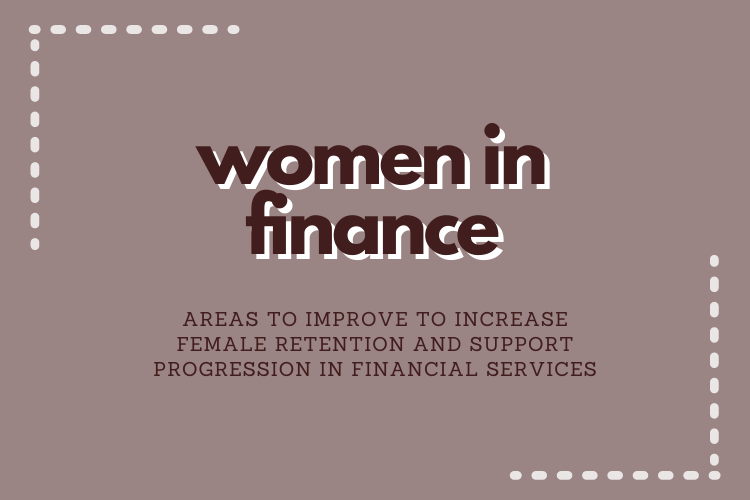In many countries, women represent over 50% of the workforce in the financial services industry and yet women occupy fewer than one in five roles at executive level. This suggests that women working in financial services face significant barriers that prevent or slow down their career progression. In fact, data from the 30% Club reveals that women’s probability of progression from middle to senior levels of management relative to their male counterparts is worse in financial services than in any other sector.
The pandemic has adversely affected female representation within financial services further, with many firms putting their diversity and inclusion agendas on hold while they tried to navigate the more pressing concerns generated by COVID-19. Simultaneously, women felt ‘increased pressure’ during the pandemic as the main caregivers in their households.
As society returns to a sense of normality, a renewed focus on how financial services firms can increase female retention and support their career progression will be needed to address gender disparity. The following points identify areas companies should seek to improve to increase female representation within financial services at every level.
Sponsorship
Despite more females entering the field, women remain significantly underrepresented in the upper levels of financial services companies. One factor possibly preventing female progression may be the lack of accessible role models or sponsors within the industry, who could support and guide entry-level women.
Promising young male employees frequently benefit from informal mentoring or sponsorship, typically from a senior male colleague. This senior figure will then champion the junior employee in the assignment of promotions, projects and resources, and advocate on their behalf during performance meetings.
Comparatively, women in financial services often do not have access to role models, mentors or sponsors - making it harder for them to navigate what is already a challenging career path. Interestingly, whereas senior level women come to view sponsorship as the factor most essential to success, entry-level women believe that performance is the strongest driver of progression.
To address this imbalance financial firms should endeavour to build formal mentoring and sponsoring relationships for female talent entering the field, ensuring they receive the same advice and support as their male colleagues. However, this should not solely be the responsibility of senior female figures, but male leadership must also foster and support entry-level women. Both mentorship and sponsorship have often been instrumental to employee retention, higher employee success rates and promotion readiness.
Ambition Gap
Women in entry-level roles in financial services rarely imagine themselves occupying leadership positions - according to research by Mckinsey, only 26% of women aim for executive positions, compared with 40% of their male colleagues and 31% of entry-level women across all industries. Female talent entering the field commonly cite a lack of interest in senior roles, concerns about balancing family and work commitments, the perceived pressure associated with leadership roles, and too much politics as the primary reasons top jobs are less appealing.
Interestingly, women typically enter the financial services industry with the same ambition level as their male colleagues and maintain this ambition throughout the early years of their career. However, in mid-career a sizable gap opens up between men and women in their willingness to make concessions to their personal lives and in their career ambition levels - it is at this point women choose to leave the field entirely or take a career break.
Due to the lack of female talent in leadership positions in financial services, women often experience a greater visibility within the company structure. In turn, this puts additional pressure on them not to fail and therefore they typically work harder - compromising their personal lives.
Deanna Strable, executive vice president and CFO at Principal Financial Services says the ‘lack of women in C-suite positions is a self-perpetuating cycle, because we don’t have any females in the C-suite, young women don’t see role models or potential paths towards executive level leadership and are more likely to deselect themselves out of higher-level leadership roles’.
Similar to sponsorship, the financial services industry must find a way to address this ambition gap - providing inclusion initiatives that support women and open up pathways towards leadership that seem possible despite outside pressures. This may include introducing them to current leaders, providing training or addressing flexibility.
Flexibility
One of the most common reasons women at mid-career choose to leave or lack ambition is due to the perceived pressure in balancing life commitments. Normalising flexible working and career breaks should help address gender disparity in the C-suite of the financial services sector.
In many ways, the global pandemic has helped to standardise the implementation of flexible working schedules. However, flexibility is not only a structural issue but a cultural one. With many firms adopting ‘hybrid’ schemes it may offer women the possibility of both rising through the ranks and having time for family responsibilities. Although, there is concern that with a growing number of women opting for flexible schedules, and therefore out of the office more, this could prevent their career progression further.
This is why cultural change is also required - firms should endeavour to address the stigma associated with flexible work options by getting both men and women to make equal use of ‘hybrid’ schedules and parental leave. Further, companies should also look to adapt their recruitment methods to include and attract women resuming their career after a break or change. Providing both the infrastructure for flexible work and working on cultural change should help ensure talented females do not leave the workforce permanently.
Clare Jupp, Director of People Development at Brightstar Financial, said ‘I believe that if organisations are genuinely looking to achieve greater gender parity, then the change must be a cultural one and it must come from the top. Businesses must regard work/life balance and the implementation of flexible working practices as being important and available for all and should look to at least begin discussions about how a dynamic working policy could work in their organisation’.
Addressing these three areas of concern, sponsorship, the ambition gap and flexible working, should help address the gender disparity that exists within the C-suite of financial services sector - not only working on the organisational infrastructure, but pursuing cultural change.
Contact
Genevieve Higgins-Desbiens is the Head of Marketing at Rutherford, the executive specialists in legal, financial crime, cyber security and compliance recruitment.
Contact us for a confidential search, send us an email at enquiries@rutherfordsearch.com or see our latest vacancies.
Email: genevieve@rutherfordsearch.com










.png)
